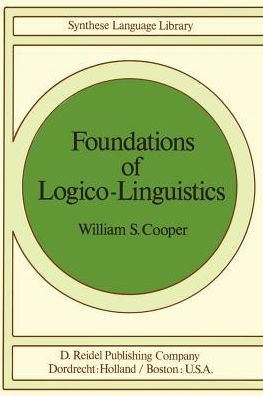5
1

Foundations of Logico-Linguistics: A Unified Theory of Information, Language, and Logic
250
by W.S. Cooper
W.S. Cooper

Foundations of Logico-Linguistics: A Unified Theory of Information, Language, and Logic
250
by W.S. Cooper
W.S. Cooper
Paperback(Softcover reprint of the original 1st ed. 1978)
$54.99
-
PICK UP IN STORECheck Availability at Nearby Stores
Available within 2 business hours
Related collections and offers
54.99
In Stock
Overview
In 1962 a mimeographed sheet of paper fell into my possession. It had been prepared by Ernest Adams of the Philosophy Department at Berkeley as a handout for a colloquim. Headed 'SOME FALLACIES OF FORMAL LOGIC' it simply listed eleven little pieces of reasoning, all in ordinary English, and all absurd. I still have the sheet, and quote a couple of the arguments here to give the idea. • If you throw switch S and switch T, the motor will start. There fore, either if you throw switch S the motor will start, or, if you throw switch T the motor will start . • It is not the case that if John passes history he will graduate. Therefore, John will pass history. The disconcerting thing about these inferences is, of course, that under the customary truth-functional interpretation of and, or, not, and if-then, they are supposed to be valid. What, if anything, is wrong? At first I was not disturbed by the examples. Having at that time consider able personal commitment to rationality in general and formal logic in particular, I felt it my duty and found myself easily able (or so I thought) to explain away most of them. But on reflection I had to admit that my expla nations had an ad hoc character, varying suspiciously from example to example.

Product Details
| ISBN-13: | 9789027708762 |
|---|---|
| Publisher: | Springer Netherlands |
| Publication date: | 04/30/1978 |
| Series: | Studies in Linguistics and Philosophy , #2 |
| Edition description: | Softcover reprint of the original 1st ed. 1978 |
| Pages: | 250 |
| Sales rank: | 1,008,536 |
| Product dimensions: | 6.10(w) x 9.25(h) x 0.24(d) |
Table of Contents
1. Introduction.- 1.1 Aims.- 1.2 Beyond Syntax.- 1.3 Bloomfield’s Dilemma.- 1.4 The Research Strategy of the Isolable Subsystem.- 1.5 Theories of Language vs. Language Analysis.- 1.6 Theories of Logic.- 1.7 Logico-Linguistics.- 2. Information and Language.- 2.1 Information States.- 2.2 Input and Output.- 2.3 Information Automata.- 2.4 Language Automata.- 2.5 Black-Box Methodology.- 2.6 The What-Do-You-Know? Game.- 2.7 The Behavior-Analytic Interpretation of Language Automata.- 2.8 The Linguistic Priority of the Language Automaton.- 2.9 Languages.- 2.10 Summary.- 3. On Describing Languages.- 3.1 Descriptive Strategies.- 3.2 Descriptive Equivalence.- 3.3 Language Descriptions as Scientific Theories.- 3.4 Basic Evidence Propeties.- 3.5 The Evidence-Gathering Process.- 4. Language and Deductive Logic.- 4.1 Idealizations.- 4.2 Logical Relationships.- 4.3 Properties of the Logical Relationships.- 4.4 Logics.- 4.5 Informative Languages have Incomplete Logics.- 4.6 Quasi-logical Relationships.- 4.7 Quasi-logical Relationships are often Logical.- 4.8 Logic in the Evidence-Gathering Process.- 5. Semantics, Axiomatics.- 5.1 Semantically Structuralizable Languages.- 5.2 Examples of Artifical Semantically Structuralizable Languages.- 5.3 A Fragment of English.- 5.4 Semantics and Deductive Logic.- 5.5 Axiomatic Language Descriptions.- 5.6 Other Language Families.- 5.7 Logic as a Branch of Linguistics.- 5.8 Syntax, Semantics, Pragmatics.- 6. Meaning.- 6.1 Purports and Imports.- 6.2 Purport-Import Glossaries.- 6.3 Specialized Glossaries.- 6.4 Synonymy.- 7. Language and Inductive Logic.- 7.1 Credibility Weights.- 7.2 Probability Weights.- 7.3 Deductive Logic in Probability-Weighted Languages.- 7.4 The Semantics of Probability-Weighted Languages.- 7.5 Plausible Inference.- 7.6Statistical Inference.- 7.7 Inductive Reasoning.- 7.8 Extended Semantics.- 8. ‘If-Then’: A Case Study in Logico-Linguistic Analysis.- 8.1 Preliminary Statement of Hypotheses to be Tested.- 82 History of Hypothesis A.- 8.3 History of Hypothesis B.- 8.4 History of Other Hypotheses.- 8.5 Delineation of Constructions of Interest.- 8.6 The Working Hypothesis of Extended Semantic Structuralizability.- 8.7 Exact Statement of Hypothesis A.- 8.8 Exact Statement of Hypothesis B.- 8.9 Remarks on Hypothesis B.- 8.10 Contraposition.- 8.11 Methodological Review.- 8.12 The Hypothetical Syllogism.- 8.13 Further Inference Patterns.- 8.14 The Paradoxes of Material Implication.- 8.15 The Second Paradox Re-examined Dynamically.- 8.16 Modus Ponens and Modus Tollens.- 8.17 Order of Premises.- 8.18 Incompatible Conditionals.- 8.19 Self-Contradictory Conditionals.- 8.20 Aristole’s Slip.- 8.21 Incompleteness of the Rules Governing Conditionals.- 8.22 Logically Disjunct Conditionals.- 8.23 Negations of Conditionals.- 8.24 Conjunctions of Conditionals.- 8.25 Conditionals Containing Other Conditionals.- 8.26 Lewis Carroll’s Barbershop Paradox.- 8.27 Disjunctions of Conditionals.- 8.28 Conclusions about If—then.- 8.29 Further Case Studies.- 8.30 Concluding Remark.- 9. Problem Areas and Computer Applications.- 9.1 Choice of Linguistic Unit.- 9.2 Ambiguity.- 9.3 Context-Dependence.- 9.4 Linguistic Incompleteness.- 9.5 Non-declarative Sentences.- 9.6 Physical Realizability.- 9.7 Automatic Question-Answering.- 9.8 Enthymemes, Analyticity.- 9.9 Further Computer Applications.- 9.10 Artificial Intelligence.- 9.11 The Future.- References.From the B&N Reads Blog
Page 1 of
